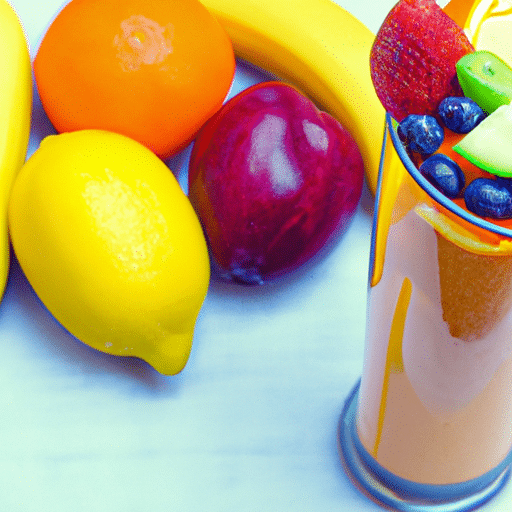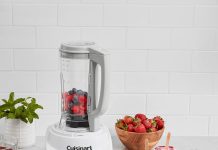Thinking about starting a healthy juicing or smoothie routine, but unsure whether to make small batches? We’re here to help you make an informed decision. In this article, we’ll explore the benefits and drawbacks of both options, highlighting the nutritional aspects, convenience factors, and taste profiles to help you choose the perfect approach for your lifestyle. From maintaining freshness and maximizing nutrient content to finding the right balance between convenience and flavor, we have all the insights you need to make the best choice for your juicing or smoothie adventures. Let’s dive in and discover the ideal method for you!
Review contents
Health Benefits
Juices and smoothies offer a myriad of health benefits that can improve our overall well-being. One of the key advantages of consuming these beverages is their high nutritional content. Both juices and smoothies are packed with essential vitamins and minerals that our bodies need to function properly. From vitamin C to potassium, these beverages provide a convenient and delicious way to meet our daily nutritional needs.
Nutritional Content
When it comes to the nutritional content, both juices and smoothies have their unique advantages. Juices, especially those made from fresh fruits and vegetables, are known for their high concentration of vitamins and minerals. By extracting the juice from the produce, we can consume a large quantity of nutrients in one go. This is particularly beneficial for individuals who struggle to eat enough fruits and vegetables throughout the day.
On the other hand, smoothies are made by blending whole fruits and vegetables, which means they retain all the fiber found in the produce. Fiber is an important component of a healthy diet as it aids digestion, regulates blood sugar levels, and promotes a healthy weight. By opting for smoothies, we not only get the nutritional benefits from the fruits and vegetables but also the added fiber content.
Fiber Content
Fiber plays a crucial role in maintaining our digestive health. It helps regulate bowel movements, prevents constipation, and supports the growth of beneficial bacteria in our gut. The fiber present in smoothies adds bulk to our stool, making it easier to pass through our digestive system. This is especially important for individuals who struggle with digestive issues or irregular bowel movements.
Moreover, the fiber in smoothies helps slow down the absorption of sugar into our bloodstream, preventing blood sugar spikes and crashes. This can be particularly beneficial for individuals with diabetes or those looking to maintain stable energy levels throughout the day. Additionally, the fiber in smoothies promotes a feeling of fullness, reducing the likelihood of overeating and aiding in weight management.
Flavor and Texture
In addition to their health benefits, juices and smoothies also offer a delightful experience for our taste buds. Both beverages provide concentrated flavors and refreshing combinations that can tantalize our senses. Whether we prefer the zing of citrus fruits or the sweetness of berries, there are endless possibilities to explore when it comes to flavor profiles.
Concentrated Flavors
Juices are known for their intense flavors, as the extraction process concentrates the natural taste of the fruits and vegetables. For example, a glass of freshly squeezed orange juice bursts with the citrusy goodness that is hard to replicate with any other method. This concentrated flavor experience allows us to enjoy the essence of our favorite fruits and vegetables without any added sugars or artificial flavors.
On the other hand, smoothies offer a more balanced flavor profile. By blending the whole fruits and vegetables, the natural flavors are harmoniously combined, creating a delicious and well-rounded taste. The texture of smoothies also adds a layer of complexity, with the creamy mouthfeel enhancing the overall flavor experience. Whether we prefer a tropical blend or a green detox smoothie, the possibilities are endless for creating flavorful concoctions that please our palates.
Smooth and Creamy Texture
Smoothies are known for their smooth and creamy texture, thanks to the inclusion of ingredients like yogurt, nut butter, or bananas. This velvety consistency adds a delightful element to the drinking experience, making it enjoyable for all. The texture of smoothies also makes them highly versatile, as we can experiment with different ingredients to achieve our desired thickness and creaminess.
Juices, on the other hand, have a thinner and more liquid texture. This makes them refreshing and hydrating, especially during hot summer days. Since juices don’t contain any additional ingredients like yogurt or ice cream, they are lighter and easier to consume. The texture of juices allows for quick and efficient hydration, making them a popular choice for individuals looking to quench their thirst and nourish their bodies.
Convenience and Preparation
When it comes to convenience and preparation, both juices and smoothies have their unique advantages. Understanding the time required and the equipment needed can help us decide which option best fits our lifestyle and preferences.
Time Required
If we’re looking for a quick and fuss-free option, juices may be the way to go. With a reliable juicer, we can extract the juice from fruits and vegetables within minutes. The process usually involves cutting the produce into small pieces, feeding them through the juicer, and collecting the liquid in a container. This method allows us to enjoy a glass of freshly pressed juice in no time, perfect for busy mornings or when we’re on the go.
Smoothies, on the other hand, require a bit more time and preparation. Blending the ingredients can take a few minutes, especially if we’re using a variety of fruits, vegetables, and additional ingredients like yogurt or ice. However, the time spent on preparing a smoothie also allows for more flexibility and creativity in terms of ingredient combinations and flavors.
Equipment Needed
To make juices, a reliable juicer is essential. There are various types of juicers available in the market, ranging from centrifugal juicers to masticating juicers. Centrifugal juicers are faster but may not extract as much juice as masticating juicers, which work at a slower speed but yield higher juice quality. Investing in a high-quality juicer ensures efficient juice extraction and a smooth juicing process.
For smoothies, a blender is the primary equipment required. Countertop blenders or personal blenders can be used to blend the ingredients into a smooth and creamy consistency. Personal blenders are particularly convenient as they come with to-go cups or containers, making it easy to blend and consume the smoothie directly from the same container.
Cost
Considering the cost aspect is essential when we incorporate juices or smoothies into our daily routine. Both the ingredients used and the potential for storage and waste can impact the overall cost.
Ingredients
The cost of ingredients for juices and smoothies varies depending on factors like seasonality, availability, and personal preferences. Fresh produce, especially organic options, can be more expensive compared to conventional ones. However, it’s worth noting that the cost of homemade juices and smoothies is generally lower than purchasing pre-made, bottled versions from stores or juice bars.
To minimize costs, we can opt for locally grown and seasonal fruits and vegetables. Buying in bulk and freezing any excess produce is also a great way to save money and reduce waste. Additionally, incorporating cost-effective ingredients like bananas or apples as a base can help stretch the budget while still enjoying a nutrient-rich beverage.
Storage and Waste
When it comes to storage and waste, juices have a shorter lifespan due to their liquid nature. Freshly made juices are best consumed immediately to maximize their nutritional content and minimize the risk of spoilage. If we do need to store juice, it’s recommended to use an airtight container and refrigerate it for no more than 24-48 hours.
Smoothies, on the other hand, have a longer shelf life due to the inclusion of fiber and other ingredients. They can be stored in the refrigerator for up to 24 hours without a significant loss in quality. One can also freeze smoothies in individual portions, allowing for convenient and quick access to a healthy beverage whenever needed.
By managing storage properly and minimizing waste, we can make the most of our ingredients and reduce unnecessary costs. It’s important to keep in mind that both juices and smoothies can be customized according to personal preferences and budget limitations.
Variety and Creativity
One of the most enjoyable aspects of incorporating juices and smoothies into our daily routine is the endless variety and creative possibilities. By exploring different ingredient combinations and experimenting with recipes, we can find unique flavors that wow our taste buds.
Ingredient Combinations
The beauty of both juices and smoothies lies in their ability to showcase various ingredient combinations. From classic combinations like orange-carrot or strawberry-banana to more adventurous blends like spinach-mango or beet-berry, there’s a whole world of flavors waiting to be explored. Mixing and matching fruits, vegetables, herbs, and even spices can result in intriguing and delicious combinations that cater to our individual tastes.
We can play with different color palettes, ensuring a visually appealing beverage and also incorporating a diverse range of nutrients. For example, including blueberries in a smoothie not only adds a vibrant purple hue but also boosts the antioxidant content. By embracing creative ingredient combinations, we can make every sip exciting and enticing.
Recipe Experimentation
In addition to ingredient combinations, the world of juices and smoothies allows plenty of room for recipe experimentation. From adding superfoods like chia seeds or spirulina to incorporating plant-based protein powders, there are countless ways to enhance the nutritional value of our beverages. We can also experiment with different textures by adding ingredients like avocado for a creamy smoothie or coconut water for a light and hydrating juice.
Furthermore, juices and smoothies can be customized to cater to specific dietary needs or preferences. Whether we’re following a vegan, gluten-free, or low-sugar lifestyle, we can adapt recipes to align with our individual requirements. The versatility of juices and smoothies makes them a flexible and inclusive option for people with various dietary restrictions and goals.
Satiety and Meal Replacement
Beyond the flavors and variety they offer, both juices and smoothies can serve as an excellent option for satiety and meal replacement. By considering the caloric intake and the filling nature of these beverages, we can make informed choices about incorporating them into our diet.
Caloric Intake
When it comes to caloric intake, it’s important to be mindful of our individual goals and needs. Juices tend to be lower in calories compared to smoothies, as they primarily consist of the extracted liquid from fruits and vegetables. This makes them a suitable option for individuals looking to reduce their overall calorie intake or maintain a specific weight.
On the other hand, smoothies can be more substantial, especially if they include additional ingredients like bananas, nut butter, or protein powder. Smoothies can serve as a meal replacement, providing a balanced combination of macronutrients and essential vitamins and minerals. They can be an excellent choice for individuals who lead an active lifestyle or need a quick and nutritious meal on the go.
Filling and Satisfying
The fiber content in smoothies makes them more filling and satisfying compared to juices. Since fiber takes longer to digest, drinking a smoothie can provide a sense of fullness and satiety that lasts longer. This can prevent unnecessary snacking or overeating, promoting healthier eating habits and weight management.
Juices, although lower in fiber, can still help curb cravings and provide a feeling of satisfaction. The concentrated flavors and refreshing nature of juices can quench our thirst and satisfy our taste buds. Including a small glass of juice as a snack or accompaniment to a meal can add a nutritious and enjoyable element to our overall diet.
Digestion and Absorption
The ease of digestion and absorption is another important factor to consider when choosing between juices and smoothies. The form and content of these beverages can impact how effectively our bodies process and absorb the nutrients they provide.
Smoothie Benefits
Smoothies, made with whole fruits and vegetables, contain the fiber that aids in digestion. The fiber helps move food smoothly through the digestive tract, preventing issues like constipation and promoting regularity. Moreover, the fiber in smoothies acts as a prebiotic, promoting the growth of beneficial gut bacteria and contributing to a healthy gut microbiome.
The presence of fiber also slows down the digestion process, allowing for a gradual release of nutrients into our bloodstream. This helps regulate blood sugar levels and prevents sudden spikes, making smoothies a suitable choice for individuals with diabetes or those looking to maintain stable energy levels.
Juice Benefits
Since juices are extracted liquids, they don’t contain the fiber found in whole fruits and vegetables. While this may be seen as a disadvantage in terms of digestion, it can actually be beneficial for individuals with digestive issues or those with sensitive stomachs. Juices provide a concentrated dose of nutrients without the added fiber, making it easier for the body to absorb and utilize the vitamins and minerals.
The liquid nature of juices also allows for quicker absorption, providing an almost instant boost of nutrients. This can be particularly beneficial for individuals who may have difficulty digesting whole foods or absorbing nutrients due to certain medical conditions. Juicing can provide a convenient and efficient way to nourish the body, especially for those who may have compromised digestion.
Maintenance of Nutrients
Preserving the nutrient content of juices and smoothies is crucial to ensure we receive the maximum health benefits. Factors like the oxidation process and consumption speed can impact the nutrient retention of these beverages.
Oxidation Process
Oxidation, caused by exposure to air and light, can lead to the degradation of certain vitamins and antioxidants in juices and smoothies. To minimize nutrient loss, it’s important to consume these beverages as soon as possible after preparation. The longer they sit, the more potential there is for vital nutrients to break down.
To slow down the oxidation process, juices can be stored in airtight containers with minimal headspace to reduce contact with oxygen. Adding a squeeze of lemon or lime juice can also help preserve the color and nutritional content. Smoothies should be consumed immediately or stored in the refrigerator for a short period to maintain their nutrient integrity.
Consumption Speed
The speed at which we consume juices and smoothies can also impact nutrient absorption. Gulping down these beverages quickly may not allow for optimal digestion and absorption of the nutrients. Taking the time to savor and slowly sip on these drinks allows our bodies to properly break down the nutrients and make the most out of them.
Additionally, thorough chewing is essential when consuming smoothies, as it aids in the release of digestive enzymes and prepares the body for efficient nutrient absorption. By being mindful of our consumption speed and incorporating mindful eating practices, we can enhance the overall benefits of these beverages.
Juicing vs. Blending
The choice between juicing and blending ultimately depends on personal preferences, health goals, and lifestyle factors. Understanding the differences in the processes and the resulting beverages can guide us in making an informed decision.
Juicing Process
Juicing involves extracting the liquid from fruits and vegetables, leaving behind the fibrous pulp. This process removes the indigestible fiber, making the nutrients more readily available for absorption. Juicing can be beneficial for individuals who have difficulty digesting fiber or those who want to quickly and efficiently obtain a concentrated dose of vitamins and minerals.
However, it’s worth noting that juicing also removes a significant portion of the fiber, which plays a critical role in digestion and overall health. Without fiber, juices may not provide the same level of satiety and digestive benefits as smoothies. Additionally, since juicing requires specialized equipment and may generate more waste, it may be less suitable for individuals seeking a cost-effective and eco-friendly approach.
Blending Process
Blending, the process of pulverizing whole fruits and vegetables, incorporates both the liquid and the fiber into the final beverage. This results in a thicker and more filling drink compared to juices. The fiber in smoothies aids digestion, promotes a feeling of fullness, and supports a healthy gut microbiome.
Smoothies can be an excellent choice for individuals seeking a well-rounded beverage that offers both nutrition and satiation. By using a high-powered blender, we can blend even the tougher parts of fruits and vegetables, ensuring maximum nutrient retention. The versatility of smoothies also allows for the inclusion of additional ingredients like yogurt, nuts, or seeds, further enhancing the nutritional profile.
Conclusion
In conclusion, both juices and smoothies offer a plethora of health benefits, each with its unique advantages. Juices provide concentrated flavors, quick nutrient absorption, and may be more suitable for individuals with specific digestive needs. On the other hand, smoothies offer the fiber content, versatility, and satiating properties that promote a healthy digestive system and overall well-being.
When it comes to convenience, juices are quick and refreshing, while smoothies offer more flexibility and creativity in terms of ingredients and flavors. Costs can be managed effectively by utilizing local, seasonal produce and minimizing waste through proper storage techniques. Ultimately, the choice between juices and smoothies depends on personal preferences, dietary goals, and lifestyle factors.
The key is to incorporate these beverages mindfully into our daily routine, ensuring a balanced diet that includes a variety of fruits and vegetables. Whether we choose to sip on a revitalizing green juice or savor a creamy berry smoothie, both options can play a valuable role in nourishing our bodies and enhancing our well-being. So, why not raise a glass and toast to the delicious health benefits of juices and smoothies? Cheers!































